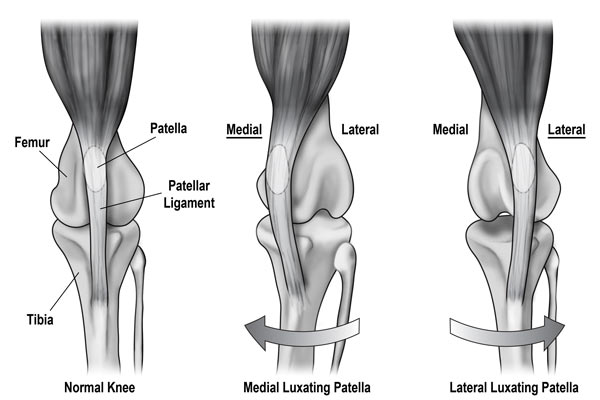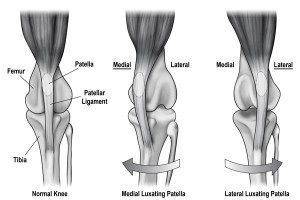Why is my Dog Limping?
While there are many different reasons your pup could be limping. One common cause in small breed dogs is from a luxating patella (kneecap).
In a healthy dog, the kneecap moves up and down smoothly in a groove, allowing good biomechanics of the knees and hips.
Unfortunately, some dog breeds are more prone to luxating patella problems (see below) and the kneecap doesn’t sit properly in the groove. It can pop out either medially (to the inside), or laterally (to the outside).
There is a genetic predisposition to luxating patellas that occurs in a variety of small breed dogs, including:
- Miniature and toy Poodles
Maltese
- Jack Russell Terriers
- Yorkies
- Pomeranians
- Pekingese
- Chihuahuas
- Papillions
- Boston Terriers
Larger breeds have less genetic predisposition to problems with the kneecap. They typically have a nice, deep groove for thepatella to sit in.
Large breed dogs are more prone to hip problems, so if a joint above the kneecap like the hip joint, or one below the kneecap like the ankle develops a problem, it can change the dog’s biomechanics. If there’s a problem with your dog’s hip, it can cause compensatory changes that forces the patella out of it’s groove.
There are four levels of severity of a luxating patella. Grade 1 (mild) through Grade 4 (severe).
- Grade 1: Describes a kneecap that pops out, but pops right back in on its own.
- Grade 2: Describes a kneecap that pops out of place and doesn’t always pop back in automatically.
- Grade 3: Describes a kneecap that sits outside its groove most of the time, but can be manually positioned back in the groove, where it stays temporarily.
- Grade 4: Describes the most severe case, in which the kneecap sits outside the groove all the time, and won’t stay in the groove.
Often in young dogs with strong, resilient joint cartilage, thepatella can pop out and back in without obvious signs of pain. There may be an intense jolt of pain as the kneecap moves across the patella ridge, but it doesn’t last long.
The dog won’t want to put weight on his leg until the kneecap has popped back in, but otherwise he/she appears fine.
Ultimately, however, as the cartilage wears down from the frequent travel of the kneecap in and out of its groove, there will be bone-to-bone contact and the condition can become acutely painful for your pup.
Diagnosis and Treatment
If your veterinarian diagnoses even a mild Grade 1 luxating patella in your pet, I recommend you address it right away.
Taking a proactive approach to treating the condition — no matter how mild, and especially in a young dog — can often prevent future surgery, joint degeneration, and diminished quality of life.
Important things to consider for a dog with a luxating patella if surgery is not indicated:
- Keep your dog at a healthy weight.This will limit stress on the joints.
- Ask your vet about an oral joint support formula to rebuild and maintain strong and resilient cartilage and joint fluid production in your dog.
- Chiropractic is also great modality for dogs with luxatingpatella, depending on the severity. There are some very effective chiropractic manipulations that can be performed to keep the hips and knees in good alignment. This will in turn help prevent progression of the condition.
- It’s very important to keep your dog moving. Maintaining excellent muscle tone will help stabilize your dog’s knee. Building muscle is an extremely important part of reducing the clinical symptoms of a luxating patella.
Below is a video testimonial of a chiropractic success story of a Boston Terrier with this particular condition.Please watch!



Recent Comments